|
V.
|

|
Some years ago the management of a large and popular hotel in this city, having added
an elaborate public room to the house, hit upon the idea of attracting attention to it by filling it up with pictures
and objects of art. Among the former the most prominent was a world-famous, large canvas
by Bouguereau, the "Nymphs Teasing a Satyr," as the artist
christened it, or "Nymphs and Satyr" as it is most generally known, and the painting by which
Luis Falero effectively established his reputation, "The Vision of Faust."
These pictures alone, and they were but part of a number more, cost many thousands of dollars.
It has been estimated, by one of the heads of the house, that they alone
have paid some ten times their cost in the amount of custom they have attracted, and relatively to the
advance in market value of modern paintings of the first class, they could now be sold for double
what was paid for them. The picture, in a technical sense, is cerainly Falero's masterpiece, as far as his
productiveness has yet proceeded.
|

|
Laurens Alma-Tadema, one of the foremost figure painters of
the century, and one of the most successful in every material sense, was born in
Belgium, at the town of Drourp in the province of Friesland, in 1836. His father was a notary,
with a quite prosperous practice, and, purposing that his son should continue his business, he educated him
with this point in view. The boy was sent to the college
at Leeuwarden, and in his leisure from school carefully trained to the office duties of his father's
profession. But the art spirit woke in him early, and asserted itself against all parental objections
and restraints. He practiced drawing secretly. He made experiments in color. He pored over the engravings
and the old missals in the college and the public library. He was particularly fascinated at the college lectures by those which related to the Greek and Roman antiquity, and while his father believed
that he was acquiring the knowledge necessary for a provincal lawyer, he was laying the foundations
for a knowledge which was to render him a greater and wealthier man than his plodding parent ever dreamed
of being. At last his pentup love for art broke forth with irresistible force. He was sixteen
years of age. It was time for him to go to work in the notary's office. He refused. His father
yielded to his supplications, and sent
him to the Antwerp Academy to become a painter. He commenced to study at Antwerp in 1852, when Wappers
and Dykmans were the professors at the Academy. In 1859 he left the Academy and entered the
studio of Baron Leys. Such a school suited such a scholar as Alma-Tadema, and he calls himself to-day
a pupil of Leys and De Taye. In 1861 he exhibited his first really worthy original
picture, and it was purchased by the King of the Belgians. This gave him not only profit
but encouragement and the commencement of a reputation. He travelled in Germany, Italy,
France; visited London; studied the works in the great collections everywhere, and worked unceasingly himself.
He made a special study of classical art and literature, and gradually, but slowly, and only
as his knowledge increased, and he felt certain of his material, gravitated towards the field of
subjects to which he eventually devoted himself and upon which his fame rests. He was already
prosperous, for his pictures sold from the easel, when he married the daughter of a wealthy
English manufacturer, whom he had met on one of his numerous visits to London. His wife,
herself, possessed strong artistic talent, and under his tutelage has become so good a painter that the
name Laura Alma-Tadema is now sought for in the catalogues of the London exhibitions.
In 1871 he settled in London, having previously had his studio in Brussels, and in
London he remains, in spite of the fact that the dynamic explosion of Regent's Park in 1874
destroyed his house and his fine classical art collection, and compeller him to build a newer - and much more palatial -home.
|
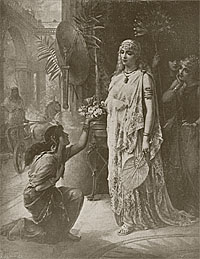
|
In "A Message" Miss Heva Coomans is
represented by another of the Pompeiian subjects which come to her, in a manner, as a sort of artistic
legacy from her father.
|

|
The Germans have a pretty legend that there is a wood-nymph who has a passion for
roses, who dwells by woodland brooks and charms mankind by the spell of the splendid flower of
love. It is this fable which Willaim Kray personifies in
"Nymph of Roses," in his usual ideal manner.
|

|
A very
great man was lost to French art in the death, a few years ago, of Gustave
Rodolphe Clarence Boulanger. He was born in Paris, in 1824, became at
fourteen years of age a student at the Ecole des Beaux Arts, and was a favorite
pupil of Jollivet and Paul Delaroche. In 1849 he won the Prix de Rome, and
travelled to Italy, where he remained, studying and painting, until 1856. Previous
to going to Rome, he had spent some months in North Africa, making studies of local life, and after completing
the term of his Government pension in Italy, he once more went to Algiers. These two sources of
study practically influenced his whole artistic career. The "Summer Bath at Pompeii" was painted in 1876 and is
esteemed one of his best pictures, upon his Italian motives. He was made a member of the Legion
of Honor in 1865, and when he died was a Chevalier, or Officer, of the order.
|
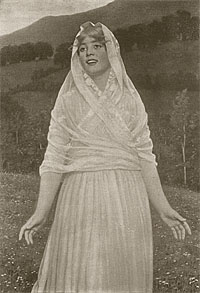
|
Luigi Mion, a rising young French artist, typifies
"Early Morning" as a maiden in gauzy white robe and drapery,
suggestive of the early mist, who smiles joyously out of a rich midsummer landscape,
with the fields dotted with daisies.
|
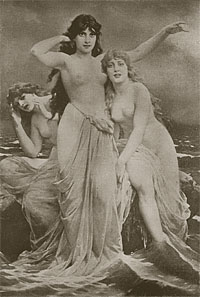
|
Friedrich Paul Thumann, who was born at
Tschaksdorf, in the Lausitz, in 1834, was originally intended for a scientific career, and studied with that purpose
at the engineering school at Glogau. At the age of nineteen, however, he entered the Berlin
Academy as an art student. In 1856 he settled in Dresden, where, until 1860, he remained as a
pupil of Julius Hubner. He had now become known as a painter, both of portraits and
religious compositions, which found favor. In 1860
he removed to Leipzig, the great German publishing centre, where as a draughtsman
and illustrator for books and periodicals he acquired both a wide reputation and a great deal of money.
This enabled him in 1863 to resume his study of painting, which he did under Professor Pauwels at Weimar.
After travelling in Italy, France and England, he in 1866 became a professor at the Weimar
Academy, which he exchanged six years later for the Academy at Dresden, and in 1875 for a
similar post in Berlin, where he still remains.
"The Sirens" is an
extremely characteristic work from his brush, and gives a new view of a subject which has
already been treated in "Modern Figure Painting" by different artists.
|
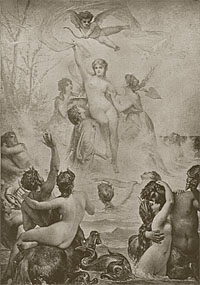
|
In "The Triumph of Venus"
one may obtain a clear comprehension of the manner of composition and treatment of the eminent French
artist Felix Joseph Barrias. Barrias is a native of Paris,
born in 1822, where his father was a painter on porcelain. This trade the parent taught the son,
and he was such an apt scholar that at the age of sixteen he was able to earn his own
living by it, and to enter the studio of Cogniet for instruction in a higher walk of art. In 1844
he captured the Prix de Rome and went to Italy, and his "Exiles of Tiberius" in 1850, which is
now in the Luxembourg collection, confirmed his position and secured him a medal of the
first class, then a very rare recompense. Nine years later he received the cross of the Legion
of Honor for a historical painting, representing one of the movements of the French army in the Crimean
War.
|
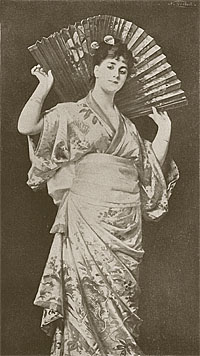
|
"Yum Yum" presents
Nathaniel Sichel in a new aspect, with a full length figure of a European
lady in Japanese masquerade.
|

|
We have already given one artistic version of the conflicting
ancient stories of the death of Orpheus. From the easel of Emile Joseph Millochau
comes an episode of another. He adopts the tale that instead of having been killed by
a thunderbolt from Jove, Orpheus, having refused to worship Dionysus, was by the latter's command
torn to pieces by the Maenades or Bacchantes. The artist shows one of the
repentant Maenades, who has stolen away from her companions and is mourning
over the head of the singer in whose cruel slaughter she assisted.
The artist is a native of Paris, and was a pupil of Cabanel and of Feyen Perrin.
|
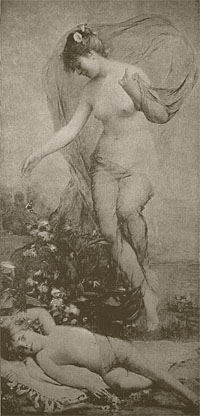
|
Gaston Gerard
is another French painter, but one who adheres more closely to decorative than classical lines.
In his "Voice of Evening" he suggests the hour lulling the
world to sleep with her soft notes of song.
|
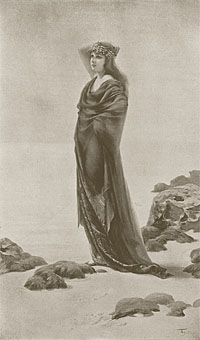
|
The spirit of the sea, as embodied by Luis Falero in
"Marina," is a young and lovely
woman, crowned with pearls, and wearing a robe of green and gold, the colors of the royal
seaweeds, who wanders on the strand as in a realm of dreams.
|

|
The "Undine" of William Kray is a subject whose
suggestion is derived by the artist from the well-known tale of the water-fairy. It was first exhibited
at the Munich Exposition of 1879, and added much to the artist's reputation.
|

|
"Flowers' Revenge" comes from an old legend called "The Revenge of the Roses."
According to this tale, a beautiful but cruel woman had a passion for roses. Her exactions devasted
the gardens of the land, until the poor roses, in their despair, appealed to their mistress
Venus for protection, and she granted them the power to destroy life as well as to delight the senses.
Once more only did the cruel beauty ravage the garden beds. Next morning she was
found dead on her sumptuous couch, and the flowers which had triumphed over her
bloomed around her in exultation. The painter, Emil Doerstling,
is a Berlin man, and a graduate of the Royal Academy of that city.
|
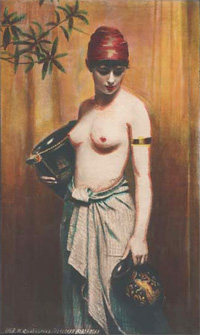
|
Max Nonnenbruch, who has
who has been introduced to the reader in a previous section of this work, appears at his best
"here in A Greek Slave."
|
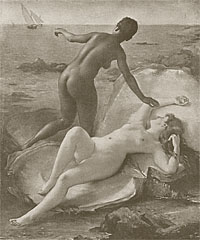
|
F. Lequesne is a son of the eminent Parisian sculptor
Eugene Louis Lequesne, and received his first instruction in art from his father.
"The Two Pearls" is one of a number of striking pictures which
have attracted attention to him in different Salon exhibitions.
|
|
|
|





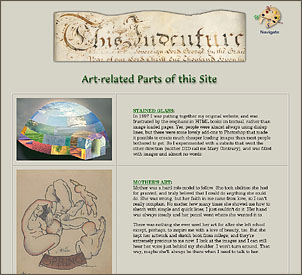



![]() Copyright © 2007, Mary S. Van Deusen
Copyright © 2007, Mary S. Van Deusen